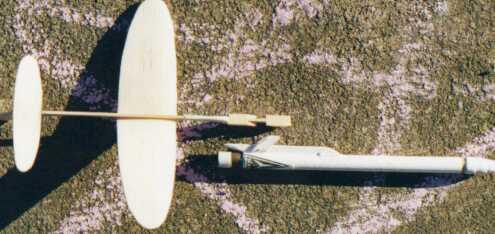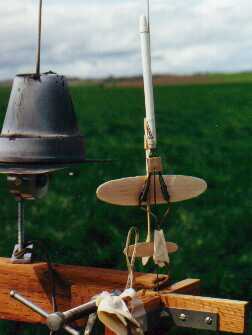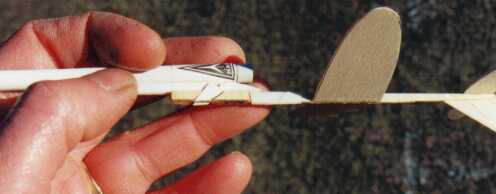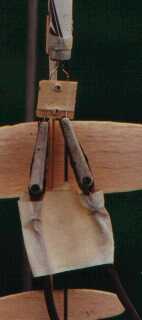Scratch MicroSoar Ellipse Original Design / Scratch Built
Scratch - MicroSoar Ellipse {Scratch}
Contributed by Peter Clay
| Manufacturer: | Scratch |

As soon as I got my hands on some Quest Micro-Maxx motors, my first thought was to build a glider. The first, Flit, had only a 3" wingspan, pudgy, thick wings, and balsa body stick. The second, Flake, may be seen elsewhere in EMRR because it was an entry in DesCon V. In both cases I was thrilled with a 35-foot boost and six-second glide, but I kept fiddling with the design to try to refine both boost and glide. I started making them radically lighter and experimented with extremely high aspect ratio. That one glided well, but had a lot of drag on boost; less aspect ratio might be a good thing. I built this glider light and delicate like the high aspect ratio version, but with dimensions more like the earlier models.
This one has flown twice. The first flight, at a local park, it was up there for over 30 seconds before hitting the top of a tree in a backyard across the street. A boy who lived in that house was watching and retrieved the glider from the base of the tree for me.
 The second flight was at our club
launch near Sheridan, April 15, 2000. In front of more than a hundred people
this thing boosted straight up and stayed up 61 seconds. The pod was recovered
twenty feet from the pad. The glider was seen landing and found about 50 yards
downrange.
The second flight was at our club
launch near Sheridan, April 15, 2000. In front of more than a hundred people
this thing boosted straight up and stayed up 61 seconds. The pod was recovered
twenty feet from the pad. The glider was seen landing and found about 50 yards
downrange.
Part of the fun of this was putting it in contrast with George Rachor's Ecee Thunder which had just completed the second of two excellent flights on D12-3.
A word of caution: I've built a number of these, but only this one has performed at this level. With tiny gliders like this, balance and alignment is extremely critical and luck played a big part in hitting the right numbers with this one. I really never finished it; I meant to round off some rough edges and corners, but I'm afraid to do that now for fear it will mess up the balance.
Parts and Dimensions:
Body stick is a basswood HO scale 2x4, about 1x2.5mm, 120 mm long. Sometimes I use 1/16" x 1/8" spruce. Wing is 1/16" A-grain contest balsa tapered by sanding to about 2/3 that thick at the tip. Tail surfaces are 1/32" C-grain contest balsa.
Wing span: 101 mm; and chord: 25.4 mm. Stab span 51mm; and chord 12.6 mm Rudder, glued to bottom, consists of 1/2 of an identical stab cutout, cut at 45 degrees through the center point. Stab is glued flat on top. In some copies of this design, I use an inverted butterfly design with two tail panels dropped 30 degrees from the top of the body stick, and no central rudder. In general, each tail style works about as well as the other.
Total weight of this glider: 0.8 gram +/- 0.1 gram.

Pod Mount:
The body tube for this pod was hand-rolled from regular paper on a 1/4" (6mm) steel rod -- specifically, the blade of a long #2 Phillips screwdriver. The nose cone is a piece of 1/4" maple dowel sanded round at the front, with a shoulder built up with two wraps of glued paper.
There is a pod hook on either side of the center rail. Unlike previous designs, the hook is alongside the motor, not trailing behind it.
Shock cord is 6" (15 cm) of braided Kevlar® material. I punched a small hole in the body tube at the leading end of the pod rail, pulled about 1/2" (13mm) of cord through the hole, and glued it to the outside of the body tube against the rail. A streamer made of crepe paper or aluminized Mylar about 15 x 90 mm is simply taped to the Kevlar® cord just below the nose cone. I used ordinary Estes recovery wadding.
 Launch
Setup:
Launch
Setup:
Clip leads are taped to the launch rod with masking tape. MicroMaxx ignitor, with black shell removed, is held by clips. Pod of glider rests on ignitor, which is inserted into nozzle. Be sure clips and wires are positioned so that the glider tail clears them on lift-off.
The glider simply hangs on the pod mount. The angled hook keeps it in place while the motor is thrusting and as long as the pod's inertia is greater than the glider's. At ejection, the shallow 30° angle of the backside of the hook simply pushes the glider away.
Sponsored Ads
 |
 |











